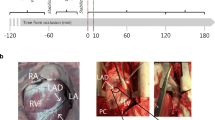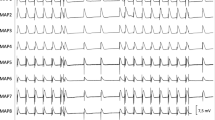Summary
The aim of the present study was to investigate the dose-dependent antiarrhythmic efficacy of lidocaine against electrically induced tachycardias in conscious, chronically instrumented postinfarction dogs. Programmed electrical stimulation (PES) was performed in 16 dogs 8 to 21 days after a 4 h occlusion of the left anterior descending coronary artery (LAD). Infusion of saline in 8 control animals with sustained ventricular tachycardia (SVT) inducible at baseline did not affect subsequent inducibility. In the treatment group 7 of 8 animals responded with SVT and one exhibited ventricular fibrillation at baseline. After an initial bolus of 1 mg/kg lidocaine intravenously (i.v.), the drug was infused at infusion rates of 40, 80 and 120 μg/kg/min (i.v.). During 80 μg/kg/min lidocaine (mean plasma level 3.5 μg/ml) 7 out of 8 animals displayed an antiarrhythmic response; both the lower and the higher infusion rate were associated with a smaller antiarrhythmic efficacy (3 of 8 animals responded to 40 μg/kg/min and 4 of 8 to 120 μg/kg/min). Licocaine did not affect ventricular refractory periods, but induced an increase in intraventricular conduction time at all infusion rates, from 66.2 ms at baseline to 67.7 ms (p<0.05), 67.7 ms (p<0.05), 70.0 ms (p<0.01) respectively.
In conclusion the present study demonstrates that lidocaine is of considerable value in the management of PES-induced ventricular arrhythmias in the postinfarction phase. However there is only a small optimal therapeutic plasma level range, where lidocaine exhibits its antiarrhythmic efficacy against this type of arrhythmia; this makes a carefully titration of the drug necessary both in the experimental and in the clinical setting.
Similar content being viewed by others
References
Alderman EL, Kerber RD, Harrison DC (1974) Evaluation of lidocaine resistance in man using intermittent high-dose infusion techniques. Am J Cardiol 34:342–349
Anderson JL (1984) Current understanding of lidocaine as an antiarrhythmic agent: a review. Clin Ther 6:125–141
Anderson KP, Walker R, Lux RL, Ershler PR, Menlove R, Williams MR, Krall R, Moddrelle D (1990) Conduction velocity depression and drug-induced ventricular tachyarrhythmias. Effects of lidocaine on the intact canine heart. Circulation 81:1024–1038
Brodsky MA, Allen BJ, Luckett CR, Capparelli EV, Wolff LJ, Henry WL (1989) Antiarrhythmic efficacy of solitary beta-adrenergic blockade for patients with sustained ventricular tachyarrhythmias. Am Heart J 118:272–280
Collinsworth KA, Kalman SM, Harrison DC (1974) The clinical pharmacology of lidocaine as an antiarrhyhthmic drug. Circulation 50:1217–1230
Davis J, Glassman R, Wit AL (1972) Method for evaluating the effects of antiarrhythmic drugs on ventricular tachycardias with different electrophysiologic characteristics and different mechanisms in the infarcted heart. Am J Cardiol 49:1176–1184
Duff HJ, Mitchell LB, Wyse DG (1985) Mexiletine-quinidine: Frequency-dependent changes in ventricular refractoriness associated with antiarrhythmic efficacy. Circulation 72 [Suppl III]:111–164
Furukawa T, Rozanski JJ, Moroe K, Gosselin AJ, Listere JW (1989) Efficacy of procainamide on ventricular tachycardia: Relation to prolongation of refractoriness and slowing of conduction. Circulation 118:702–708
Gerstenblith G, Spear JF, Moore EN (1972) Quantitative study of the effect of lidocaine on the threshold for ventricular fibrillation in the dog. Am J Cardiol 30:242–247
Gianelly R, Groeben JO, Spivack AP, Harrison DC (1967) Effect of lidocaine on ventricular arrhythmias in patients with coronary heart disease. N Engl J Med 277:1215–1219
Hunt GB, Ross DL (1989) Influence of infarct age on reproducibility of ventricular tachycardia induction in a canine model. J Am Coll Cardiol 14:765–773
Iesaka Y, Aonuma K, Nitta J, Tokunaga T, Fujiwara H, Hiraoka M (1988) Effects of procainamide and lidocaine on electrically inducible ventricular tachycardia studied with programmed ventricular stimulation in post myocardial infarction. Jpn Circ J 52:262–271
Janse MJ, Wit AL (1989) Electrophysiological mechanisms of ventricular arrhythmias resulting from myocardial ischemia and infarction. Physiol Rev 69:1049–1169
Karagueuzian HS, Fenoglio JJ, Weiss MB, Wit AL (1979) Protracted ventricular tachycardia induced by premature stimulation of the canine heart after coronary artery occlusion and reperfusion. Circ Res 44:833–846
Krumpl G, Todt H, Schunder-Tatzber S, Raberger G (1989a) Holter monitoring in conscious dogs: assessment of arrhythmias occurring during ischemia and in the early reperfusion phase. J Pharmacol Methods 22:77–91
Krumpl G, Todt H, Schunder-Tatzber S, Raberger G (1989b) Holter monitoring in conscious dogs: assessment of arrhythmias occurring in the late reperfusion phase after coronary occlusion. J Pharmacol Methods 22:93–102
Krumpl G, Todt H, Schunder-Tatzber S, Raberger G (1990) Programmed electrical stimulation after myocardial infarction and reperfusion in conscious dogs. J Pharmacol Methods 23:155–169
Lynch JJ, Heaney LA, Wallace AA, Gehret JR, Stein RB (1990) Failure of lidocaine to suppress lethal ischemic ventricular arrhythmias in a canine model of previous myocardial infarction. J Cardiovasc Pharmacol 16:41–49
Miyazaki T, Ogawa S, Sakai T, Hosokawa M, Sakurai K, Nakamura Y (1988) Effects of class I drugs on reentrant ventricular tachycardia in a canine model of myocardial infarction: On their antiarrhythmic and proarrhythmic mechanisms. Jpn Circ J 52:254–261
Patterson E, Gibson JK, Lucchesi BR (1982) Electrophysiologic actions of lidocaine in a canine model of chronic myocardial ischemic damage — Arrhythmogenic actions of lidocaine. J Cardiovasc Pharmacol 4:925–934
Patterson E, Gibson JK, Lucchesi BR (1988) Antiarrhythmic and arrhythmogenic actions of methyl lidocaine during the recovery phase after canine myocardial infarction. Pharmacology 36:73–83
Reiter MJ, Easley AR, Mann DE (1987) Efficacy of class Ib (lidocainelike) antiarrhythmic agents for prevention of sustained ventricular tachycardia secondary to coronary artery disease. Am J Cardiol 59:1319–1324
Schmitt C, Brachmann J, Waldecker B, Rizos I, Senges J, Kübler W (1987) Amiodarone in patients with recurrent sustained ventricular tachyarrhythmias: results of programmed electrical stimulation and long-term clinical outcome in chronic treatment. Am Heart J 114:279–283
Smeets JLRM, Allessie MA, Lammers WJEP, Bonke FIM, Hollen J (1986) The wavelength of the cardiac impulse and reentrant arrhythmias in isolated rabbit atrium. Circ Res 58:96–108
Todt H, Krumpl G, Krejcy K, Raberger G (1991) Comparison of the antiarrhythmic effects of dl-sotalol and d-sotalol in a conscious canine model of recent myocardial infarction. Z Kardiol 80 [Suppl 3]:41
Todt H, Krumpl G, Krejcy K, Raberger G (1992) Mode of QT correction for heart rate: implications for the detection of inhomogeneous repolarisation following myocardial infarction. Am Heart J (in press)
Van de Water A, Verheyen J, Xhonneux R, Reneman RS (1989) An improved method to correct the QT interval of the electrocardiogram for changes in heart rate. J Pharmacol Methods 22:207–217
Wilber DJ, Lynch JJ, Montgomery D, Lucchesi BR (1985) Postinfarction sudden death: significance of inducible ventricular tachycardia and infarct size in a conscious canine model. Am Heart J 109:8–18
Author information
Authors and Affiliations
Additional information
Send offprint requests to K. Krejcy at the above address
Rights and permissions
About this article
Cite this article
Krejcy, K., Krumpl, G., Todt, H. et al. Lidocaine has a narrow antiarrhythmic dose range against ventricular arrhythmias induced by programmed electrical stimulation in conscious postinfarction dogs. Naunyn-Schmiedeberg's Arch Pharmacol 346, 213–218 (1992). https://doi.org/10.1007/BF00165304
Received:
Accepted:
Issue Date:
DOI: https://doi.org/10.1007/BF00165304




